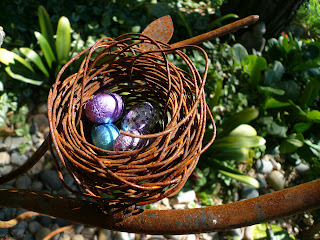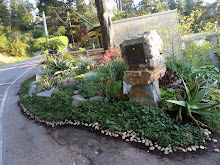Saturday, May 3, 2008
Peony

Most herbaceous types are hardy from Zone 8 to Zone 2, with some exceptions.
The best-known herbaceous species isPaeonia lactiflora, also known as the Chinese peony because of extensive breeding work done by Chinese horticulturalists. The popular double-flowered cultivars that most of us grow almost all come from this species.
Most varieties flower for about a week in late spring to early summer, but you can extend the period of bloom for six weeks by choosing early, mid- and late-season cultivars.
Flower colors range from white and yellow to shades of red, pink and mauve - any color except blue. As for scent, most double flowering types are more fragrant than singles, and pinks tend to be more fragrant than reds.
Steps to peony success
Soil and light: Peonies grow two to four feet tall and thrive in sunny flowerbeds and well-drained soils. Although they tolerate a wide range of soil types, you'll have the best success with good soil rich in organic matter.
Feeding: These perennials are heavy feeders, but whether or not you need to add fertilizer depends on the type of soil you have. Clay soils tend to be more fertile than sandy soils. With sandy soils, adding nutrients will help ensure your plants thrive.
It's better to use compost or well-rotted manure to feed perennials than chemical fertilizers. Top dressing around your peonies each fall with compost does a lot to improve the soil structure as well as its nutritional content, however, don't dump the compost directly on the crown of the plant, but rather in a circle around the plant.
If compost isn't available, use a granular fertilizer higher in phosphate and potassium than nitrogen and scratch it into the soil around the crown in early spring and fall.
We have two peonies and just one flower for each peony/year. The fragrant is so wonderful.
Iris

Irises are wonderful garden plants. As the word Iris means rainbow, irises come in so many colors: blues and purples, whites and yellows, pinks and oranges, browns and reds, and even blacks. The genus Iris has about 200 species and is native of North Temperate regions of the world
Types of Irises
Irises are classified into two major groups: rhizome irises and bulbous irises. Within those groups are countless species, varieties, cultivars and hybrids, according to the American Iris Society.
Rhizome irises are thickened stems that grow horizontally, either underground or partially underground. After planting, iris rhizomes produce swordlike leaves that overlap, forming flat fans of green foliage. Three popular irises in this group are Bearded, Beardless and Crested irises. Bulbous irises grow from bulbs that require a period of dormancy after they have bloomed. The bulbous irises are typically smaller than rhizome irises and usually produce smaller blossoms.
The bearded iris has four distinct parts: Standards, Falls, Stigma flaps, Beard
The beardless variety has : Standards, Falls and Stigma flaps, but usually have crests
The crested Irises or Evansia Iris: Standards, Falls and Stigma flaps and in addition to a ridge on the falls of the blossom, they have ridges like crests instead of beards
Crested iris are often considered in the same manner as the beardless iris. These plants spread freely by underground stems and produce flat flowers in the shades of blue, violet and white. Often the flowers and leaves are found on bamboo like stems which can vary in height from 5-200 centimeters in height.





















